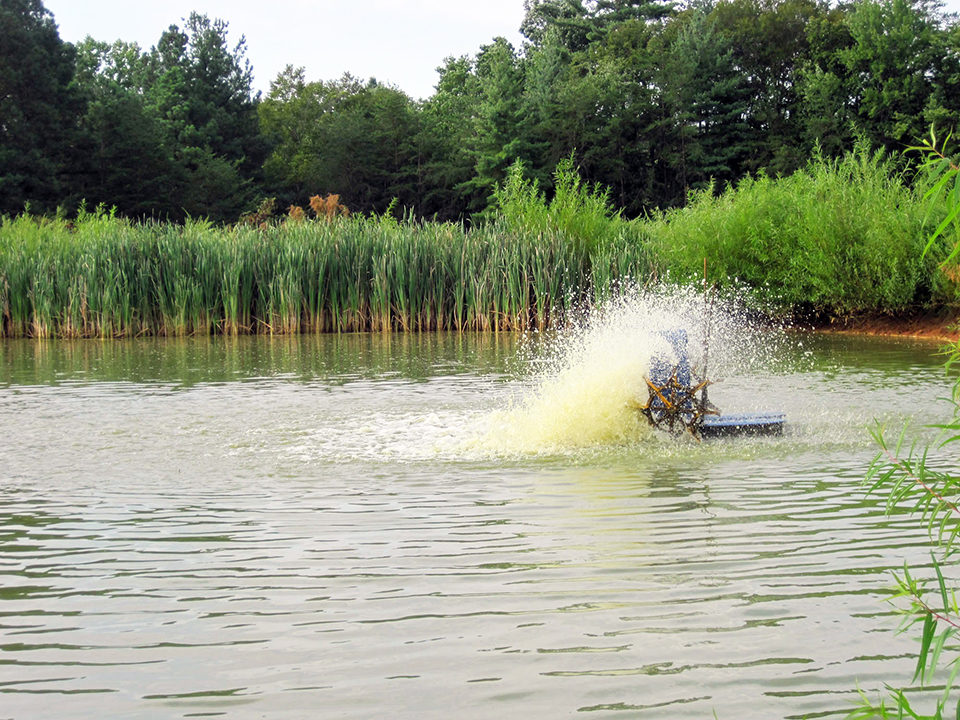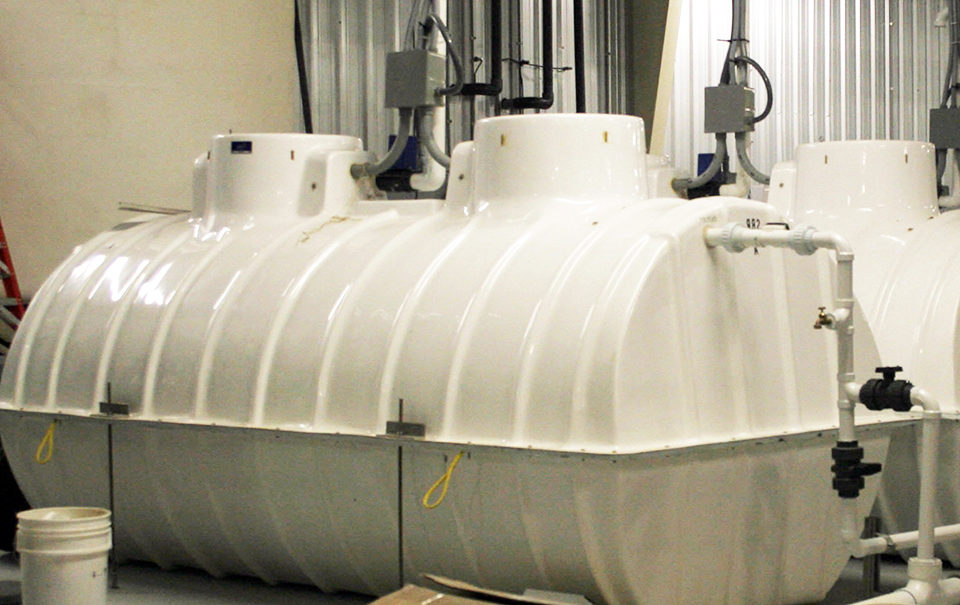In-situ, ex-situ systems improve water quality, provide nutrition

Bioflocs are suspended material in the water column, constituted by a consortium of microorganisms, micro- and macroinvertebrates, filamentous organisms, exocellular polymers, feces and uneaten feed. Implementing biofloc technology to culture shrimp and fish in ponds and recirculating systems can offer several advantages, including improvement of water quality and animal nutrition.
There are two primary biofloc systems for aquaculture production: in-situ technology and ex-situ technology. When properly implemented, each biofloc system has unique benefits and limitations.
In-situ bioflocs
In-situ bioflocs are formed in culture ponds or tanks by manipulating the carbon:nitrogen ratio (C:N) to values of 8:1 or higher. This can be accomplished by supplementing a carbon source such as sucrose, molasses, glycerin or calcium acetate. Alternatively, it has been shown that low-protein feeds can also result in a higher C:N ratio in the culture water.
Providing the appropriate C:N ratio promotes the growth of heterotrophic bacteria while assimilating ammonia directly from the water column into bacteria biomass. Under high C:N ratio conditions, heterotrophic bacteria are the primary components of bioflocs. Shrimp and fish can graze on these bioflocs for nutrition.
Ex-situ bioflocs
Ex-situ bioflocs are formed in suspended-growth biological reactors. Biological reactors can be employed to remove accumulated solids and nitrate from aquaculture production effluent waters. Carbon supplementation can also be used to promote biological activity.
Bioflocs produced in the biological reactors can be used as a feed supplement for shrimp or fish. The cleaned effluent water can then be reused for aquaculture production or discharged from the production facility.
Water quality
With in-situ biofloc technology, bioflocs can assimilate ammonia directly into microbial proteins, thereby preventing the accumulation of nitrate from nitrification. Ex-situ biofloc systems receive effluent water from aquaculture production that contains accumulated nitrate and then removes the nitrate under anoxic conditions. The in-situ technology has an advantage over the ex-situ technology because the in-situ process directly mitigates nitrogen wastes and is favorable with regard to microbiological energetics.
In-situ biofloc systems have a very high oxygen demand because the culture animals and bioflocs are in the same water. Shrimp and fish typically require greater than 5 mg/L dissolved oxygen. Since bioflocs also use dissolved oxygen when it is available, bioflocs contribute significantly to oxygen demand in the water. Oftentimes, when high levels of bioflocs are present, the amount of oxygen used by the bioflocs can exceed that used by the culture animals.
Ex-situ biofloc systems have an advantage over in-situ biofloc systems because the bioflocs are produced externally from the culture animals in a biological reactor. Therefore, the primary oxygen demand is from shrimp or fish. Even though nitrification has some oxygen demand, it is minimal compared to the requirement of the animals.
Bioflocs in the biological reactor can be beneficial for denitrification under anoxic conditions. If the operator chooses to implement oxygen as part of the cycling within the biological reactor, the oxygen requirement is only 1 mg/L.

Animal nutrition
In-situ biofloc technology is often beneficial to shrimp and fish because it offers a source of nutrition. Bioflocs in these systems often contain a modest amount of energy, lipids, minerals and protein. Shrimp and some fish such as tilapia can graze on the bioflocs and thus reduce the amount of commercial feed needed. However, there is little control over how much biofloc is consumed by the animals.
Bioflocs produced externally using ex-situ biofloc technology are also nutritious. However, the bioflocs must be moved from the biological reactor to the culture tanks or ponds, where their application can be controlled in much the same way as using commercial feeds.
Bioflocs concentrated by settling, centrifuging or filtering can be used as a feed supplement for shrimp or fish. Bioflocs can also be concentrated and/or dried for use as an ingredient in aquaculture feeds.
There is limited control over the nutritional profiles of bioflocs produced using in-situ biofloc technology. However, bioflocs produced using ex-situ biofloc technology can be controlled for their nutritional compositions. Culturists can manipulate the energy, lipid, mineral and protein content of bioflocs by adjusting how they operate the biological reactors. For example, by reducing the average biofloc age in the biological reactor, the operator can increase protein content.
Bioflocs produced in both in-situ and ex-situ systems are often attributed to improving the growth of shrimp and fish. At the current time, scientists are trying to determine what bioflocs contribute to the accelerated growth. It could be an unknown chemoattractant, growth factor, stress resistance factor or a lesser-known nutritional component such as a bioamine, dipeptide, nucleotide, oligopeptide or oligosaccharide.
(Editor’s Note: This article was originally published in the July/August 2012 print edition of the Global Aquaculture Advocate.)
Authors
-

David Kuhn, Ph.D.
Department of Food Science and Technology
Virginia Polytechnic Institute and State University
FST Building (0418)
Blacksburg, Virginia 24061 USA -
Addison Lawrence, Ph.D.
Project Leader
Texas AgriLife Research
Texas A & M University System
Port Aransas, Texas, USA
Tagged With
Related Posts

Aquafeeds
Biofloc and clear-water RAS systems: a comparison
This study compared two types of indoor, shrimp culture systems: clear-water RAS and biofloc systems. Clearwater RAS had the edge in water quality, but shrimp in the biofloc treatment had a higher feed conversion ratio.

Aquafeeds
Biofloc consumption by Pacific white shrimp postlarvae
The stable isotopes technique with δ13C and δ15N can be used to determine the relevance of different food sources to shrimp feeding during the pre-nursery phase of Litopenaeus vannamei culture. During this trial, different types of commercial feed, microalgae, Artemia sp. nauplii and bioflocs were used as food sources.

Aquafeeds
Biofloc systems viable for tilapia production
Well-designed and managed biofloc technology systems are a viable alternative for production of various species like tilapia, to increase feed efficiency by lowering aquafeed protein requirements and to help reduce or eliminate effluent discharges.

Health & Welfare
Biofloc technology holds potential for carnivorous fish species
Juvenile carnivorous African catfish performed well in biofloc-based systems, which could help produce better quality and more disease-resistant seed of this important aquaculture species and support the expansion of African catfish farming industry.


